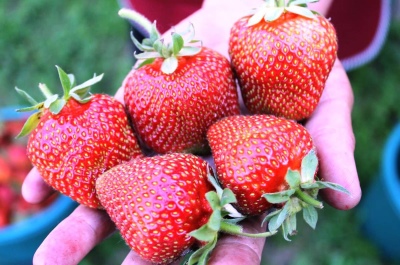
- Authors: America
- Taste: sweet with original pineapple flavor
- The size: large
- Weight: up to 50-70 gr
- Yield rate: high
- Yield: 2 kg per m2
- Repairability: Yes
- Ripening terms: medium
- Appointment: universal
- Description of the bush: low-leafed, well-blown by the wind
Brighton garden strawberries are appreciated for the compactness of the bush, high yield and large berries. The variety is planted in most regions of our country.
Description of the variety
Brighton strawberry is a common berry that belongs to the group of semi-renovated plants. The variety was bred by American breeders, it is distinguished by a bountiful harvest and easy maintenance.
It is noteworthy that the variety is suitable for industrial cultivation. Large berries are not damaged during transportation.
Ripening terms
Strawberries are classified as neutral daylight varieties, which allows the bush to grow and bear fruit at any time of the day. The first berries appear in central Russia already at the beginning of summer. In more northern regions, strawberries begin to bear fruit in mid-June, in southern ones - in mid-May. The duration of the emergence of new berries lasts until autumn.
Yield
During the period of active fruiting, it is possible to remove up to 800 g of large berries from an adult bush. In good seasons, the total weight of fruits from a bush reaches 1 kg.
Berries and their taste
Strawberry fruits have a beautiful shape characteristic of this plant. The average weight of one berry is 50-70 grams, but there are also record holders among fruits weighing up to 80 g.
The skin of the berries has a reddish-orange hue and is highly dense. Strawberry, with its characteristic strawberry aroma, tastes like a cross between pineapple and wild strawberry.
Growing features
In the process of growing bushes, it is necessary to regularly moisten the soil in the garden. On hot days, you need to water the strawberries at least once every 2-3 days; on cooler days, the interval can be increased to 5 days. One adult bush accounts for up to 3 liters of water.




Site selection and soil preparation
Brighton is a demanding strawberry variety. The place for planting future bushes should be:
- open sunlight and well warmed up;
- protected from drafts and strong gusts of cold wind;
- water and air permeable;
- nutritious, consisting of loose loam and sandy loam;
- with a neutral or slightly acidic soil-soil composition.
Groundwater must pass at a depth of at least 0.5 m. Otherwise, the strawberries will quickly flood and rot.

Pollination
It is carried out by insects during the period of bud formation. If strawberries are grown at home, you should take care of artificial pollination of flowers.
Top dressing
The variety requires regular feeding due to its long fruiting period and high yield. Fertilizers are recommended to be applied at least 4 times:
- in the middle of spring after the snow has completely melted;
- during the formation of buds;
- at the end of the first month of summer, when the first harvest will be harvested;
- 2-3 weeks after the end of fruiting.
The first feeding should include nitrogen, then mineral fertilizers or organic matter can be used.
Additionally, experienced gardeners recommend resorting to mulching the bushes. The deposited sheet material will not allow the soil to "bake" on the surface, which will ensure the flow of necessary substances and moisture to the roots.

One of the important techniques in strawberry care is feeding. Regular fertilization guarantees a rich harvest. There are several different ways to feed strawberries, and each of them is designed for a specific period of plant development. During flowering, fruiting and after it, feeding should be different.
Frost resistance and the need for shelter
The variety is quite frost resistant and can survive frosts down to -20-25 degrees Celsius. At lower temperatures, you will have to take care of the shelter of the strawberries.

Diseases and pests
Breeders have provided Brighton with reliable immunity against most types of fungal diseases. The only exception is root rot, which is often the culprit of the grower.
Pests are also not interested in eating an unusual bush. Strawberries only attract the attention of the spider mite. Onions and garlic planted next to them in the garden will protect from the parasite.
Preventive protection of the variety will be provided by weakly concentrated formulations that can be bought at a garden store. Proper watering will help get rid of rot. In this case, 2-3 times a month it is worth replacing the water with a solution of a fungicide of biological origin. The concentration of this solution should be reduced by 2-3 times.

Strawberries are often subject to many dangerous diseases that can seriously undermine their condition. Among the most common are powdery mildew, gray mold, brown spot, anthracnose, and verticillosis. Before buying a variety, you need to inquire about its disease resistance.
Reproduction
Although Brighton does not differ in the active formation of a mustache, the most common way of breeding a bush is precisely by dividing the mustache. Breeding stages:
- select several "uterine", large whiskers aged 2 years;
- in the spring, buds are cut off from the mustache;
- in June, new whiskers begin to form, of which the gardener leaves up to 7 of the most powerful;
- as soon as roots from 1 cm long have formed on the new mustache, the sprouts are separated from the bush and transplanted into the soil nearby or in small pots.
After 15 days, the grown bush is transplanted to a permanent place, cutting off the mustache. The transplant procedure is usually carried out in July-August.



















































































